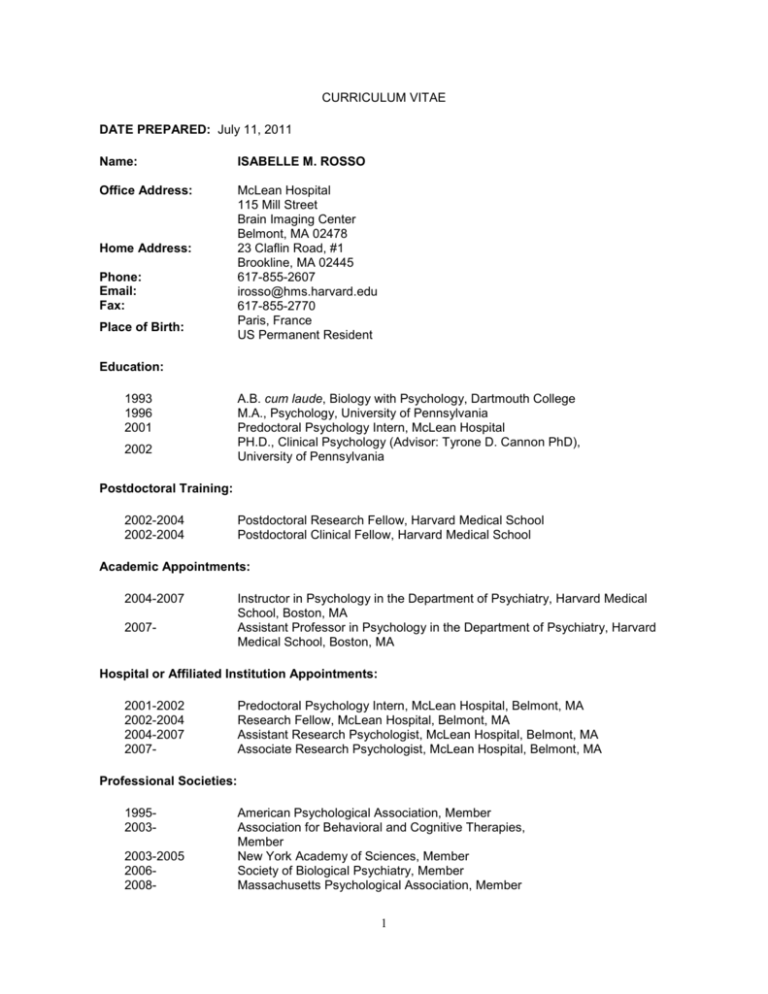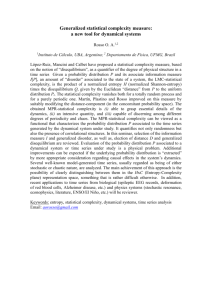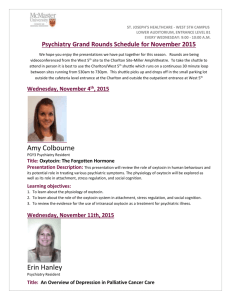Resume - Center for Depression, Anxiety and Stress Research
advertisement

CURRICULUM VITAE DATE PREPARED: July 11, 2011 Name: ISABELLE M. ROSSO Office Address: McLean Hospital 115 Mill Street Brain Imaging Center Belmont, MA 02478 23 Claflin Road, #1 Brookline, MA 02445 617-855-2607 irosso@hms.harvard.edu 617-855-2770 Paris, France US Permanent Resident Home Address: Phone: Email: Fax: Place of Birth: Education: 1993 1996 2001 2002 A.B. cum laude, Biology with Psychology, Dartmouth College M.A., Psychology, University of Pennsylvania Predoctoral Psychology Intern, McLean Hospital PH.D., Clinical Psychology (Advisor: Tyrone D. Cannon PhD), University of Pennsylvania Postdoctoral Training: 2002-2004 2002-2004 Postdoctoral Research Fellow, Harvard Medical School Postdoctoral Clinical Fellow, Harvard Medical School Academic Appointments: 2004-2007 2007- Instructor in Psychology in the Department of Psychiatry, Harvard Medical School, Boston, MA Assistant Professor in Psychology in the Department of Psychiatry, Harvard Medical School, Boston, MA Hospital or Affiliated Institution Appointments: 2001-2002 2002-2004 2004-2007 2007- Predoctoral Psychology Intern, McLean Hospital, Belmont, MA Research Fellow, McLean Hospital, Belmont, MA Assistant Research Psychologist, McLean Hospital, Belmont, MA Associate Research Psychologist, McLean Hospital, Belmont, MA Professional Societies: 199520032003-2005 20062008- American Psychological Association, Member Association for Behavioral and Cognitive Therapies, Member New York Academy of Sciences, Member Society of Biological Psychiatry, Member Massachusetts Psychological Association, Member 1 2009- Anxiety Disorders Association of America, Member Grant Review Activities: 2005 2005 Ad-Hoc Reviewer, National Institutes of Health, Behavioral Genetics and Epidemiology Section (BGES) External Ad Hoc Reviewer, Ontario Mental Health Foundation, Research Committee Editorial Boards: 2010- Development and Psychopathology Ad-Hoc Reviewer: 199920002001200220022002200520052006200620062007200820082011- Development and Psychopathology Schizophrenia Bulletin Psychological Medicine Schizophrenia Research Brain and Language Neurobiology of Aging Psychological Bulletin Evidence-Based Mental Health Journal of Adolescence Neuropsychologia Psychiatry Research: Neuroimaging Biological Psychiatry Archives of General Psychiatry Neuroimage American Journal of Psychiatry Honors and Prizes: 1989 1993 1993 1995 1998 French Baccalauréat, magna cum laude, Lycée Français de Belgique, Belgium Golden Key National Honor Society Rufus Choate Scholar Award, Dartmouth College University Fellowship, University of Pennsylvania Dean's Scholar Award, University of Pennsylvania Report of Funded and Unfunded Projects Completed 2005-2010 Current 2009-2014 “Adolescent neural substrates of risk for schizophrenia” N.I.H. 5 K01 MH069687 Principal Investigator Major Goal: The principal aim of this career development grant is to provide the applicant with training in structural magnetic resonance imaging and to apply this training to a study of adolescents at heightened familial risk for schizophrenia. “Neurobiological consequences of binge alcohol consumption in young adults” N.I.H. 5 R01 AA018153 (PI Silveri) Co-investigator 2 2010-2013 2010-2012 2011-2014 Major Goal: The aim of this study is to examine the effects of binge alcohol consumption on brain metabolites and cognitive function in 18-24 year olds using magnetic resonance spectroscopy (MRS) and neuropsychological assessment. “Proton spectroscopy of inhibitory neurotransmission in post-traumatic stress disorder” (PI Rosso) The Dana Foundation Principal Investigator Major Goal: The goal of this study is to identify neurochemical abnormalities in PTSD using proton magnetic resonance spectroscopy (MRS) at 4 Tesla. We will examine whether alterations in gamma-aminobutyric acid (GABA) are associated with PTSD diagnosis and PTSD symptoms. “Sex difference in hippocampal function and neurochemistry” N.I.H. 2 R21 AA018724 (PI Silveri) Co-investigator Major Goal: The overall aim of this proposed study is to examine sex differences in hippocampal neurochemistry and function in psychiatrically healthy 22-35 year old adults by applying high field (4.0Tesla) in vivo magnetic resonance spectroscopy (MRS) techniques in conjunction with neuropsychological assessment of verbal and spatial learning and memory. “Internet-based cognitive behavioral therapy: Effects on depressive cognitions, brain functions.” USAMRMC. (PI Rauch) Co-investigator Major goal: The primary objective of this study is to examine the effectiveness of an Australian internet cognitive behavioral therapy (iCBT) approach for alleviating symptoms of major depression in a sample of U.S. citizens. Specifically, we will test hypotheses that iCBT reduced depressogenic automatic thoughts, and increases measures of coping and resilience. A second objective is to demonstrate the effectiveness of iCBT at changing brain activation patterns in a manner consistent with knowledge of mechanisms of other proven therapies for depression. REPORT OF LOCAL TEACHING AND TRAINING Formal Teaching in Courses 1997 Teaching Assistant, University of Pennsylvania Responsibility: Held group and individual study and review sessions for a college undergraduate course in Abnormal Psychology. Developed and graded examinations. Effort: 3-4 hours/week. 1997 Teaching Assistant, University of Pennsylvania Responsibility: Held group and individual study and review sessions for a college undergraduate course in Personality Psychology. Developed and graded examinations. Effort: 3-4 hours/week. 1998 Teaching Assistant and Lecturer, University of Pennsylvania Responsibility: Prepared and delivered lectures for an undergraduate course in Abnormal Psychology. Held individual study and review sessions; graded examinations. Effort: 5-6 hours/week. 1998 Teaching Assistant, University of Pennsylvania Responsibility: Held group and individual study and review sessions for an undergraduate course in Developmental Psychology. Also helped develop and grade examinations. Effort: 3-4 hours/week. 2009- Train and supervise research assistants in the administration of the Structured Clinical Interview for DSM-IV (SCID). Effort: 1-2 hours/week. 3 Laboratory and Other Research Supervisory and Training Responsibilities 2000Train and supervise research assistants in various research skills and activities including, study advertisement, subject screening, statistical analyses, manuscript preparation. Supervision/mentorship available daily or as needed. Formally Supervised Trainees 2000-2001 2000-2001 2002-2003 2002-2004 2002-2004 2002-2005 2003-2006 2005- 2007 2006- 2009 2006- 2009 2009 - 2011 2009 2010 2010 - Rachel Loewy, PhD Tara Niendam, PhD Lisa Femia, PhD Golfo Tzilos, MA Norah Simpson, MA Ashley Young, MA Ashley Cerny, BA Katherine Rudich, BA Alexandra McCaffrey, BA Katherine Dahlgren, BA Melissa Weiner, BS Zachary Schwab, BS Dave Crowley, BA Michael Covell, BA REPORT OF REGIONAL, NATIONAL AND INTERNATIONAL INVITED TEACHING AND PRESENTATIONS Invited Presentations and Courses National “Temporal lobe NAA in first-episode schizophrenia and bipolar disorder: preliminary evidence of 2003 diagnostic specificity,” International Congress for Schizophrenia Research, Santa Fe, New Mexico “Shared and differential patterns of cortico-limbic activation across anxiety disorders -- & future 2011 research directions”, Center for Depression, Anxiety and Stress Research, McLean Hospital, Belmont, Massachusetts International 2006 “Prefrontal-limbic brain maturation and risk for psychopathology in adolescence”, American Psychiatric Association, Toronto, Canada 2008 “Regional prefrontal cortex volumes in young adults at genetic risk for schizophrenia,” University of Edinburgh, Division of Psychiatry, Special Lecture Series CURRENT LICENSURE 2007 - Licensed Psychologist and Health Services Provider, Commonwealth of Massachusetts PRACTICE ACTIVITIES 1996-1997 Psychological Testing, University of Pennsylvania, Philadelphia, PA Clinical Activity Description: Administered psychodiagnostic assessments for a general hospital psychiatry adolescent and adult treatment program. Assisted psychiatrists in formulating diagnoses and treatment plans by conducting extensive batteries of personality, intellectual and achievement tests, including the Rorschach, TAT, MMPI-II, WAIS-III, WMS-III, and Woodcock Johnson Achievement Tests. Diagnostic issues included ADHD, mood and anxiety 4 disorders, and learning disabilities. Patient Load: 15 hours/week Psychotherapy, Substance Abuse Treatment & Research Center, University of 1997-1998 Pennsylvania, Philadelphia, PA Clinical Activity Description: Conducted individual behavior therapy of adult dual diagnosis outpatients at a substance abuse treatment clinic. Treatment issues included depression, anxiety, medication management, activity scheduling, relapse prevention, and crisis planning. Patient Load: 10 hours/week Neuropsychological Testing, Veterans Affairs Hospital, Philadelphia, PA 1998-1999 Clinical Activity Description: Conducted neuropsychological testing, interpretation, and report writing in the Neuropsychology department of a VA hospital. Tests included the Wisconsin Card Sorting Task, Grooved Pegboard, California Verbal Learning Test, and Boston Naming Test. Diagnoses included a variety of psychiatric and neurologic problems, including depression, traumatic brain injury, stroke, ADHD, and learning disabilities. Patient Load: 10-15 hours/week Psychotherapy and Neuropsychological Testing, University of California, Los 1999-2001 Angeles Clinical Activity Description: Provided neuropsychological and personality testing, and psychodynamic therapy at the UCLA Psychology Department Clinic. Administered and interpreted psychological test including the WAIS-II, Woodcock Johnson Achievement Tests, MMPI-II, and WMS-III. Diagnostic issues included major depression, ADHD, and learning disabilities. Patient Load: 10-15 hours/week Psychology Intern, McLean Hospital, Belmont, MA 2001-2002 Clinical Activity Description: Provided individual and group therapy, psychodiagnostic assessment and case-management for adolescent and adult psychiatric patients in partial hospital, inpatient, and outpatient settings. Led groups on illness education, symptom management, mood regulation, activity scheduling, cognitive distortions, impulse control, stress management, and relapse prevention. Presenting diagnoses included schizophrenia, bipolar disorder, major depression, post-traumatic stress disorder, panic disorder, anorexia nervosa, and borderline personality disorder. Patient Load: 8 groups/week, 20 individual sessions/week Psychotherapy, Behavioral Health Partial Hospital Program, McLean Hospital, 2002 Belmont, MA Clinical Activity Description: Provided individual and group cognitive-behavioral therapy, psychodiagnostic assessment, and case-management services to psychiatric patients in partial hospital, inpatient, and outpatient settings. Presenting problems included schizophrenia-spectrum disorders, mood and anxiety disorders, eating disorders, and borderline personality disorder. Patient Load: 10 groups/week, 25 individual sessions/week Psychotherapy, Obsessive Compulsive Disorder Institute, McLean Hospital, 2003-2004 Belmont, MA Clinical Activity Description: Provided individual behavioral therapy (exposure and response prevention) for adults in a residential treatment program for obsessivecompulsive disorder. Patient Load: 2/week Psychotherapy, Klarman Eating Disorders Center, McLean Hospital, Belmont, 2004-2005 MA Clinical Activity Description: Led weekly motivational interviewing therapy and dialectical behavior therapy groups in an adolescent residential treatment program for eating disorders. Patient Load: 2 groups/week 2007- present Private Practice, Individual Psychotherapy (cognitive-behavior therapy) with 5 adults, particularly adults with obsessive compulsive disorder. Patient Load: 2-4 individual sessions/week REPORT OF SCHOLARSHIP Peer-Reviewed Publications Research Investigations 1. Cannon TD, Rosso IM, Bearden CE, Sanchez LE, Hadley T. A prospective cohort study of neurodevelopmental processes in the genesis and epigenesis of schizophrenia. Developmental Psychopathology. 1999; 11(3):467-85. 2. Rosso IM, Bearden CE, Hollister JM, Gasperoni TL, Sanchez LE, Hadley T, Cannon TD. Childhood neuromotor dysfunction in schizophrenia patients and their unaffected siblings: a prospective cohort study. Schizophrenia Bulletin. 2000; 26(2):367-78. 3. Cannon TD, Bearden CE, Hollister JM, Rosso IM, Sanchez LE, Hadley T. Childhood cognitive functioning in schizophrenia patients and their unaffected siblings: a prospective cohort study. Schizophrenia Bulletin. 2000; 26(2):379-93. 4. Cannon TD, Rosso IM, Hollister JM, Bearden CE, Sanchez LE, Hadley T. A prospective cohort study of genetic and perinatal influences in the etiology of schizophrenia. Schizophrenia Bulletin. 2000; 26(2):351-66. 5. Bearden CE, Rosso IM, Hollister JM, Sanchez LE, Hadley T, Cannon TD. A prospective cohort study of childhood behavioral deviance and language abnormalities as predictors of adult schizophrenia. Schizophrenia Bulletin. 2000; 26(2):395-410. 6. Rosso IM, Cannon TD, Huttunen T, Huttunen MO, Lonnqvist J, Gasperoni TL. Obstetric risk factors for early-onset schizophrenia in a Finnish birth cohort. American Journal of Psychiatry. 2000; 157(5):801-7. 7. Cannon TD, Gasperoni TL, van Erp TG, Rosso IM. Quantitative neural indicators of liability to schizophrenia: implications for molecular genetic studies. American Journal of Medical Genetics. 2001; 105(1):16-9. 8. Cannon TD, van Erp TG, Rosso IM, Huttunen M, Lönnqvist J, Pirkola T, Salonen O, Valanne L, Poutanen VP, Standertskjöld-Nordenstam CG. Fetal hypoxia and structural brain abnormalities in schizophrenic patients, their siblings, and controls. Archives of General Psychiatry. 2002; 59(1):35-41. 9. Cannon TD, Rosso IM. Levels of analysis in etiological research on schizophrenia. Developmental Psychopathology. 2002; 14(3):653-66. 10. Van Erp TG, Saleh PA, Rosso IM, Huttunen M, Lönnqvist J, Pirkola T, Salonen O, Valanne L, Poutanen VP, Standertskjöld-Nordenstam CG, Cannon TD. Contributions of genetic risk and fetal hypoxia to hippocampal volume in patients with schizophrenia or schizoaffective disorder, their unaffected siblings, and healthy unrelated volunteers. American Journal of Psychiatry. 2002; 159(9):1514-20. 11. Niendam TA, Bearden CE, Rosso IM, Sanchez LE, Hadley T, Nuechterlein KH, Cannon TD. A prospective study of childhood neurocognitive functioning in schizophrenic patients and their siblings. American Journal of Psychiatry. 2003; 160(11):2060-2. 12. Rosso IM, Young AD, Femia LA, Yurgelun-Todd DA. Cognitive and emotional components of frontal lobe functioning in childhood and adolescence. Annals of the New York Academy of Sciences. 2004; 1021:355-62. 13. Rosso IM, Cintron CM, Steingard RJ, Renshaw PF, Young AD, Yurgelun-Todd DA. Amygdala and hippocampus volumes in pediatric major depression. Biological Psychiatry. 2005; 57:21-6. 14. Silveri MM, Rohan ML, Pimentel PJ, Gruber SA, Rosso IM, Yurgelun-Todd DA. Sex differences in the relationship between white matter microstructure and impulsivity in 6 adolescents. Magnetic Resonance Imaging. 2006; 24:833-41. 15. Rosso IM, Killgore WDS, Cintron CM, Gruber SA, Tohen M, Yurgelun-Todd DA. Reduced amygdala volumes in first-episode bipolar disorder and correlation with cerebral white matter. Biological Psychiatry. 2007; 61(6):743-9. 16. Gruber SA, Rosso IM, Yurgelun-Todd DA. Neuropsychological performance predicts functional recovery in bipolar patients. Journal of Affective Disorders. 2008; 105:253-260. 17. Killgore WDS, Rosso IM, Gruber SA, Yurgelun-Todd DA. Amygdala volume and verbal memory performance in schizophrenia and bipolar disorder. Cognitive and Behavioral Neurology. 2009; 22(1):28-37. 18. Torrey EF, Buka S, Cannon TD, Goldstein JM, Seidman LJ, Liu T, Hadley T, Rosso IM, Bearden C, Yolken RH. Paternal age as a risk factor for schizophrenia: how important is it? Schizophrenia Research. 2009; 14:1-5. 19. Britton JC, Stewart SE, Killgore WDS, Rosso IM, Price LM, Gold AL, Pine DS, Wilhelm S, Jenike MA, Rauch SL. Amygdala activation in response to facial expressions in pediatric obsessive-compulsive disorder. Depression and Anxiety. 2010; 27:643-51. 20. Britton JC, Rauch SL, Rosso IM, Killgore WDS, Price LM, Ragan J, Chosak A, Hezel D, Pine DS, Leibenluft E, Pauls DL, Jenike MA, Stewart SE. Cognitive inflexibility and frontal-cortical activation in pediatric obsessive-compulsive disorder. Journal of the American Academy of Child and Adolescent Psychiatry. 2010; 49: 944-53. 21. Rosso IM, Makris N, Thermenos HW, Hodge SM, Brown AE, Kennedy D, Caviness VS, Faraone SV, Tsuang MT, Seidman LJ. Regional prefrontal cortex gray matter volumes in youth at familial risk for schizophrenia from the Harvard adolescent high risk study. Schizophrenia Research. 2010; 123:15-21. 22. Silveri MM, Jensen EJ, Rosso IM, Sneider JT, Yurgelun-Todd DA. Preliminary evidence for white matter metabolite differences in marijuana dependent men using 2D J-resolved magnetic resonance spectroscopic imaging at 4 Tesla. Psychiatry Research: Neuroimaging. In press. 23. Rosso IM, Makris N, Britton JC, Price LM, Gold AL, Zai D, Bruyere J, Deckersbach T, Killgore WDS, Rauch SL. Anxiety sensitivity correlates with two indices of right anterior insula structure in specific animal phobia. Depression and Anxiety. 2010; 27:1104-10. Research publications without named authorship 1. Buka SL, Cannon TD, Torrey EF, Yolken RH, Collaborative Study Group on the Perinatal Origins of Severe Psychiatric Disorders. Maternal exposure to herpes simplex virus and risk of psychosis among adult offspring. Biological Psychiatry. 2008; 15:809-815. Non-peer-reviewed publications in print or other media 1. van Erp TGM, Gasperoni TL, Rosso IM, Cannon TD. Investigating gene-environment interaction in schizophrenia using neuroimaging. In: In: Murray J, Jones P, Susser E, van Os J, Cannon M, editors. The Epidemiology of Schizophrenia. Cambridge, UK: Cambridge University Press; 2003. p. 254-69. 2. Rosso IM, Cannon TD. Obstetric complications and neurodevelopmental mechanisms in schizophrenia. In: Cicchetti DC, Walker EF, editors. Neurodevelopmental Mechanisms in the Genesis and Epigenesis of Psychopathology. Cambridge, UK: Cambridge University Press; 2003. p. 111-37. 3. Rosso IM. Review: hippocampal volume is reduced in people with unipolar depression. Evidence Based Mental Health. 2005; 8(2):45. Thesis 7 2000 “The Role of Obstetric Complications in the Development of Schizophrenia” Presented to the faculties of the University of Pennsylvania in partial fulfillment of the requirements for the degree of Doctor of Philosophy. Abstracts (last 3 years, unpublished) 1. Silveri MM, Olson DP, Jensen JE, McCaffrey AC, Rosso IM, Yurgelun-Todd DA. Effects of binge alcohol consumption on proton metabolite T2 during emerging adulthood. Society for Neuroscience, Chicago IL, 2009. 2. Silveri MM, Jensen JE, Prescot AP, McCaffrey A, Rosso IM, Yurgelun-Todd DA. Frontal lobe GABA metabolite levels, impulsivity and cognitive response inhibition in heavy alcohol using young adults. Research Society of Alcoholism, 2009, San Diego, CA. 3. Killgore WDS, Price LM, Britton JC, Simon N, Pollack MH, Schwab ZJ, Weiner MR, Rosso IM, Rauch SL. Brain responses to masked emotional faces in PTSD: Disorder and Valence Specificity. McLean Research Day, Belmont MA, 2009. 4. Rosso IM, Makris N, Britton JC, Price LM, Gold AL, Deckersbach T, Killgore WDS, Rauch SL. Anxiety sensitivity correlates with insular cortex volume and thickness in specific animal phobia. Society of Biological Psychiatry, New Orleans LA, 2010. 5. Rosso IM, Makris N, Thermenos HW, Hodge SM, Brown A, Kennedy D, Caviness VS, Faraone SV, Tsuang MT, Seidman LJ. Regional temporal lobe gray matter volumes and memory functioning in youth at familial risk for schizophrenia from the Harvard adolescent high risk study. Society of Biological Psychiatry, New Orleans LA, 2010. 6. Rosso IM, Makris N, Britton JC, Price LM, Gold AL, Deckersbach T, Killgore WDS, Rauch SL. Anxiety sensitivity correlates with insular cortex volume and thickness in specific animal phobia. Society of Biological Psychiatry, New Orleans LA, 2010. 7. Killgore WDS, Price LM, Britton JC, Simon N, Pollack MH, Schwab ZJ, Weiner MR, Rosso IM, Rauch SL. Paralimbic responses to masked emotional faces in PTSD: Disorder and valence specificity. Society of Biological Psychiatry, New Orleans LA, 2010. 8. Killgore WDS, Britton JC, Schwab ZJ, Weiner MR, Rosso IM, Rauch SL. Exaggerated amygdala responses to masked fearful faces are specific to PTSD versus specific phobia. 27th Army Science Conference, Orlando, FL, 2010. 9. Rosso IM, Killgore WDS, Britton JC, Weiner MR, Schwab ZJ, Rauch SL. Neural correlates of PTSD symptom dimensions during emotional processing: a functional magnetic resonance imaging study. 49th Annual Meeting of the American College of Neuropsychopharmacology, Miami Beach, FL, 2010. 10. Killgore WDS, Britton JC, Rosso IM, Schwab ZJ, Weiner MR, & Rauch SL. Shared and differential patterns of amygdalo-cortical activation across anxiety disorders. 49th Annual Meeting of the American College of Neuropsychopharmacology, Miami Beach, FL, 2010. 11. Crowley DJ, Covell MJ, Killgore WDS, Schwab ZJ, Weiner MR, Acharya D, Rosso IM, Silveri MM. Differential influence of facial expression on inhibitory capacity in adolescents versus adults. Abstract accepted for presentation at the International Neuropsychological Society, Boston MA, February 2-5, 2011. 12. Silveri MM, Crowley DJ, Covell MJ, Acharya D, Sneider JT, Rosso IM, Jensen EJ. Developmental differences in impulsivity are related o frontal lobe neurochemistry in adolescence. Abstract accepted for presentation at the Society for Research in Child Development, Montreal Canada, 2011. 13. Rosso IM, Killgore WDS, Britton JC, Weiner MR, Schwab ZJ, Rauch SL. Hyperarousal and reexperiencing symptoms of post-traumatic stress disorder are differentially associated with limbic-prefrontal brain responses to threatening stimuli. Abstract accepted for presentation at the International Neuropsychological Society, Boston MA, February 2-5, 2011. 14. Killgore WDS, Britton JC, Rosso IM, Schwab ZJ, Weiner MR, & Rauch SL. Similarities and 8 differences in cortico-limbic responses to masked affect probes across anxiety disorders. Abstract accepted for presentation at the 39th Annual Meeting of the International Neuropsychological Society, Boston, MA, February 2-5, 2011. 15. Killgore WD, Rosso IM, Britton JC, Zchwab ZJ, Weiner MR, Rauch SL. Cortico-limbic activation differentiates among anxiety disorders with and without a generalized threat response. Abstract accepted for presentation at the McLean Hospital Research Day, January 13, 2011. 16. Rosso IM, Makris N, Britton JC, Price LM, Gold AL, Deckersbach T, Killgore WDS, Rauch SL. Anxiety sensitivity correlates with two indices of right anterior insula structure in specific animal phobia. Abstract accepted for presentation at McLean Hospital Research Day, January 13, 2011. 17. Killgore WD, Rosso IM, Britton JC, Zchwab ZJ, Weiner MR, Rauch, SL. Cortico-limbic activation differentiates among anxiety disorders with and without a generalized threat response. Abstract submitted for presentation at the 66th Annual Meeting of the Society for Biological Psychiatry, San Francisco, CA, May 12-14, 2011. 18. Silveri MM, Crowley DJ, Covell MJ, Acharya D, Sneider JT, Rosso IM, Jensen JE. In vivo GABA levels in the adolescent frontal lobe: Implications for understanding ontogenetic changes in alcohol sensitivity. Research Society on Alcoholism, 2011; Atlanta, GA. Narrative report of Research, Teaching, and Clinical Contributions I am a licensed psychologist with both pre- and postdoctoral research training in major psychopathology and psychiatric neuroimaging. My current position is as a full-time researcher at McLean Hospital’s Center for Depression, Anxiety and Stress Research. Most of my research during graduate school focused on elucidating adverse obstetric influences that confer vulnerability to schizophrenia during early brain development. While these “obstetric complications” are robust correlates of schizophrenia, controversy remains concerning their mechanism(s) of effect, their relationship with genetic risk factors, and their contribution to clinical and neuropathological characteristics of the disorder. As a graduate student under Dr. Tyrone Cannon, I published 10 peerreviewed articles that examined these issues using multimodal assessments (psychiatric, neuropsychological, neuroimaging) of schizophrenia patients, their unaffected siblings, and healthy comparison subjects. This body of work sparked my interest in identifying neurobiological and behavioral markers of risk and disease processes in psychiatric illness, and led to my pursuit of postdoctoral training in psychiatric neuroimaging. As a postdoctoral fellow, I obtained an NIMH K01 mentored grant that provided me with training in magnetic resonance imaging (MRI) and spectroscopy (MRS) methods at McLean Hospital’s Brain Imaging Center. During the course of the K01, I authored and co-authored 9 peer-reviewed publications applying MR methods to affective disorders, schizophrenia, and substance dependence. The K01 funding allowed me to develop neuroimaging collaborations at McLean Hospital and Massachusetts General Hospital (MGH). At MGH, I collaborated with Drs. Larry Seidman and Nikos Makris on a study of adolescents with a family history of schizophrenia. We have been identifying structural brain deviations that covary with familial risk for schizophrenia, which will allow us to identify premorbid biomarkers that may have implications for early identification and prevention of the illness. During this period, I also joined Dr. Scott Rauch’s laboratory at McLean Hospital and have been contributing to his R01 study comparing the neural substrates of three anxiety disorders. For instance, using structural MRI, we are examining deviations in regional cortical brain volumes and thickness across several anxiety disorders (panic disorder, specific phobia, and post-traumatic stress disorder (PTSD)). My MRS work extends to collaborations with Dr. Marisa Silveri, with whom I am a co-investigator on two NIH grants. A year ago, I was able to combine my new expertise in MRS and PTSD, along with my new collaborators and mentors, to obtain a first independent grant from The Dana Foundation. This seed funding has allowed for the collection of exciting preliminary MRS data in PTSD, which I recently leveraged in a first R01 submission to the NIMH (July 2011). This submission proposes to conduct the first MRS study of regional brain γaminobutyric acid (GABA) in PTSD, and therefore to examine whether GABA might be a neurobiological marker of the disorder. Due to my longstanding interest in endophenotypes, I hope to 9 later examine whether any GABA alterations identified in the first study reflect vulnerability for PTSD versus manifestation and progression of the disease process. This would lead to studies of unaffected first-degree relatives, as well as studies of PTSD patients early versus late in the course of illness etc. Future research directions also will include examination of whether GABA alterations in PTSD are sensitive to treatment, and examination of their diagnostic specificity within the anxiety disorders. Similarly, it will be important to understand moderating effects of depression, which is frequently comorbid with PTSD. My current teaching activities consist of training and supervising research assistants and postdoctoral students. This entails a variety of activities including didactic teaching of statistical and research methods, clinical training and supervision, and supervision of daily research activities. For instance, I teach research assistants to prepare manuscripts for publication. Most recently, I have been teaching research assistants to conduct psychiatric interviews of adult subjects, using the Structured Clinical Interview for DSM-IV (SCID). This includes 6 weekly didactic lessons on general interviewing skills and techniques, and administration of specific SCID items. Students then practice administering the SCID with me present during the interview until they are able to administer the SCID on their own with posthoc supervisory meetings. In terms of clinical activities, since being at McLean I have both been employed and have volunteered as an individual and group psychotherapist on a number of the hospital's units across multiple levels of care. I am licensed as a Psychologist and Health Service Provider in Massachusetts (MA 8795) and currently have a small private practice specializing in individual cognitive behavior therapy for adults with anxiety disorders, especially obsessive-compulsive disorder. 10





